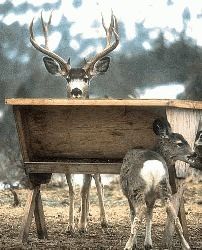Snow drives elk to feed stations
Published 12:00 am Thursday, January 8, 2004

- Deep snow in the mountains is forcing wildlife into the valley, where state-run feed stations distract deer and elk from making raids on ranch haystacks. (Baker City Herald/S. John Collins).
By JAYSON JACOBY
Of the Baker City Herald
Every morning Eddie Miguez ponders his work slate, and every evening he tallies the waning day’s toil in tons.
Tons of snow plowed.
Tons of alfalfa hay loaded.
Tons of alfalfa hay unloaded.
Tons of famished elk and deer that will raid the nearest rancher’s haystacks unless Miguez and his crew continue to dish out the grub.
Every day.
No matter how much snow falls, or how deep the wind-driven drifts become, or how close the mercury comes to the bulb at the bottom of the thermometer.
Miguez manages the Oregon Department of Fish and Wildlife’s (ODFW) Elkhorn Wildlife Area.
State officials created the Wildlife Area in 1971. Its mission is to ensure that deer and elk, which are forced by cold and snow to migrate from their summer range in the mountains to the the valley, do not help themselves to the hay that ranchers put up to feed their cattle.
To accomplish that task, Miguez and four other workers feed elk and deer at nine sites along the eastern base of the Elkhorns from Auburn, southwest of Baker City, to Shaw Mountain northwest of North Powder.
Before Christmas, Miguez and his crew saw about as many magpies as they did deer and elk during their daily rounds maybe 150 head (not including the magpies).
These days they see about 2,050, including about 1,500 elk.
The blizzards and the sub-zero temperatures that have prevailed since Christmas lured deer and elk to ODFW’s feed sites in much the same way that the pizza delivery guy’s knock on a dorm door brings a horde of salivating college students on the run.
andquot;We’re going full bore at all sites,andquot; Miguez said Wednesday afternoon. andquot;It was like, boom, they just showed up everywhere.andquot;
At Auburn, for example, on a day before the snow came, the crew spread four bales of alfalfa.
The next day the hay showed no evidence of a single nibble.
Then a storm blew in.
The day after, the snowy ground was pure white, as if no hay had ever been there.
andquot;Everything was cleaned out and there were elk tracks all around,andquot; Miguez said.
Now the Wildlife Area crew is hauling about 50 bales of alfalfa to Auburn every day, he said.
At other sites, he said, andquot;elk were standing around waiting to be fed.andquot;
Miguez said each elk is scarfing 15 to 20 pounds of alfalfa per day.
The animals always eat a lot during their first few days at the feed sites, he said it is hunger, after all, that drives them there in the first place.
After a few days, though, the animals have curbed their hunger pangs, and their munching slows to a more sedate pace of about a dozen pounds per day.
Miguez said the elk seem to understand that fresh bales will arrive every day, and that they need not take each meal as if were the last.
But this year has been different.
The snowstorms have been interspersed with frigid temperatures that tumbled as low as 20 below zero.
andquot;With these cold nights the elk just eat quite a bit more than what they normally would, and it’s mostly to create body heat,andquot; Miguez said. andquot;They haven’t slowed down (eating) at all. If it stays like this we’ll have no trouble going through all the hay.andquot;
Just three weeks ago, going through all the 665 tons of hay stacked in the Wildlife Area’s sheds seemed about as likely as an 80-degree afternoon.
During the first 20 days of December, Miguez and his crew hauled less than a dozen tons of alfalfa.
During the latter 10 days they forked out almost 50 tons.
But December’s total of 58 tons still ranks as a pittance compared to previous years.
In December 2001, for example, when snow lay deep all month, the Wildlife Area workers distributed 225 tons of alfalfa.
Elk consumed 855 tons that winter, including 80 tons that Miguez had to buy in late winter to fortify the Wildlife Area’s depleted sheds.
Despite the Antarctican weather of the past two weeks, both elk and deer seem healthy and strong, Miguez said.
When winter arrives late, as it did this year, the animals usually weather the season well, he said.
The killing winters are the ones that begin before Thanksgiving and persist, with just a few brief thaws, into March.
Baker County’s herds haven’t endured such a winter since 1992-93.
But for Miguez and his crew, this winter already seems sufficiently harsh.
Miguez awoke Wednesday intending to conduct a census of the feed sites.
Instead he spent the day driving a bulldozer through the basketball hoop-high snowdrifts sculpted by the latest blustery storm.
andquot;We’ve been so busy trying to plow snow and everything that we haven’t had time to count (the animals),andquot; Miguez said.


